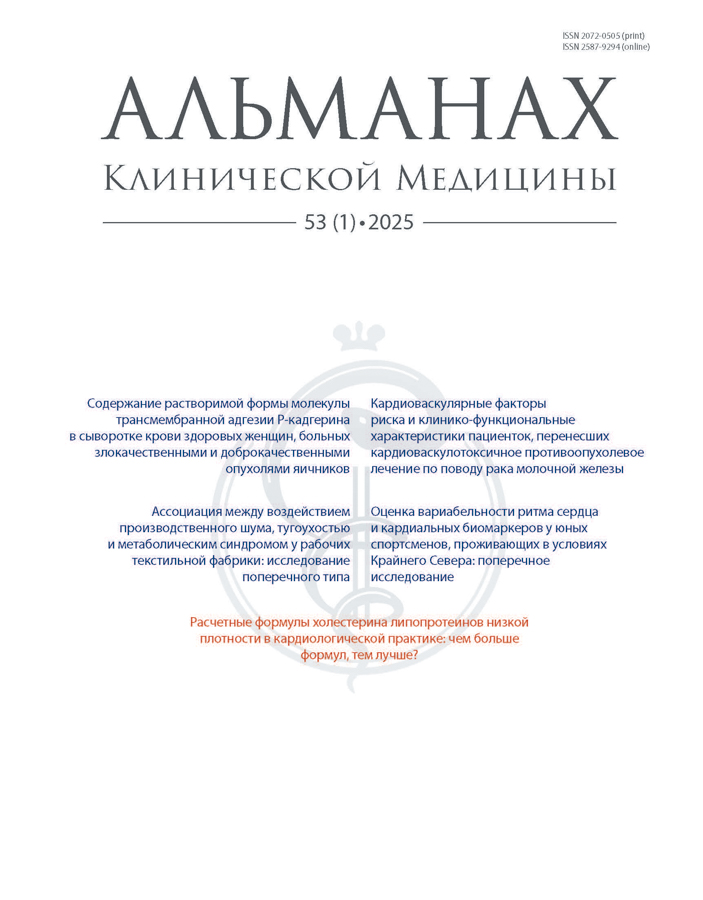Возможности стандартных технологий лучевой диагностики посттравматических изменений молочных желез
- Авторы: Касаткина Л.И.1, Лежнев Д.А.2, Смысленова М.В.2, Абдураимов А.Б.1, Калецкая Т.Г.1
-
Учреждения:
- «Маммологический центр» (Клиника женского здоровья) – филиал ГБУЗ г. Москвы «Московский клинический научно-практический центр имени А.С. Логинова ДЗМ»
- ФГБОУ ВО «Московский государственный медико-стоматологический университет имени А.И. Евдокимова» Минздрава России
- Выпуск: Том 49, № 1 (2021)
- Страницы: 21-28
- Раздел: ОРИГИНАЛЬНЫЕ СТАТЬИ
- URL: https://almclinmed.ru/jour/article/view/1418
- DOI: https://doi.org/10.18786/2072-0505-2021-49-003
- ID: 1418
Цитировать
Полный текст
Аннотация
Актуальность. Стандартного алгоритма обследования пациенток с травмой молочной железы не существует, так как обычно такие травмы не вызывают значительных последствий для здоровья. Вместе с тем, по данным клинико-инструментального обследования и с учетом разнообразия лучевой картины, посттравматические изменения молочной железы могут симулировать злокачественное поражение, что представляет собой непростую дифференциальную задачу для врача лучевой диагностики.
Цель – изучить возможности цифровой маммографии и ультразвукового исследования (УЗИ) в диагностике посттравматических изменений молочной железы и описать их семиотические проявления.
Материал и методы. Обследованы 150 женщин в возрасте от 40 до 86 лет (средний возраст 60±11.9 года) с травмой молочной железы в анамнезе. По данным цифровой маммографии с функцией томосинтеза (комбинированный режим) и мультипараметрического УЗИ изменения в молочной железе выявлены у 62 пациенток. Все результаты обследований (n=62) были интерпретированы в соответствии со шкалой BI-RADS. При необходимости верификации выявленных изменений назначалась пункционная тонкоигольная аспирационная биопсия или трепан-биопсия под стереотаксическим или ультразвуковым контролем.
Результаты. По данным маммографии типичным проявлением посттравматических изменений молочной железы был жировой некроз (n=54). Липонекроз был представлен узловыми образованиями округлой (20 из 34; 58,8%) или овальной формы (13 из 34; 38,2%) с четкими, хорошо определяемыми контурами. В большинстве случаев в них определялись включения крупных пристеночных кальцинатов (27 из 34; 79,4%). В 35,1% (19 из 54) случаев жировой некроз был представлен различными кальцинатами. По результатам УЗИ жировой некроз визуализировался как аваскулярные (40 из 40; 100%), чаще округлые (26 из 40; 65,0%), реже овальные (12 из 40; 30,0%) и гипоэхогенные (19 из 40; 47,5%) образования с четкими ровными контурами. Нетипичные проявления жирового некроза (BI-RADS 4) выявлены в 16,1% (10 из 62) случаев: выполнено 7 (11,2%) трепан-биопсий под ультразвуковым наведением и 3 (4,8%) стереотаксические биопсии. Во всех случаях подтвержден жировой некроз ткани молочной железы с различным соотношением фиброзной и некротизированной жировой ткани с лимфогистиоцитарной инфильтрацией.
Заключение. Использование стандартных лучевых методов в диагностическом алгоритме посттравматических изменений молочной железы в большинстве случаев достаточно для установления диагноза. В случаях диагностической неопределенности сохраняется необходимость морфологической верификации.
Ключевые слова
Об авторах
Л. И. Касаткина
«Маммологический центр» (Клиника женского здоровья) – филиал ГБУЗ г. Москвы «Московский клинический научно-практический центр имени А.С. Логинова ДЗМ»
Автор, ответственный за переписку.
Email: l2490193@mail.ru
ORCID iD: 0000-0002-9902-9449
Касаткина Лариса Изосимовна – заведующая отделением диагностики и лечения заболеваний молочной железы и репродуктивной системы № 2
123242, г. Москва, Верхний Предтеченский пер., 8
РоссияД. А. Лежнев
ФГБОУ ВО «Московский государственный медико-стоматологический университет имени А.И. Евдокимова» Минздрава России
Email: mail@msmsu.ru
ORCID iD: 0000-0002-7163-2553
Лежнев Дмитрий Анатольевич – доктор медицинских наук, профессор, заведующий кафедрой лучевой диагностики стоматологического факультета
127473, г. Москва, ул. Делегатская, 20–1
РоссияМ. В. Смысленова
ФГБОУ ВО «Московский государственный медико-стоматологический университет имени А.И. Евдокимова» Минздрава России
Email: fake@neicon.ru
Смысленова Маргарита Витальевна – доктор медицинских наук, профессор кафедры лучевой диагностики стоматологического факультета
127473, г. Москва, ул. Делегатская, 20–1
РоссияА. Б. Абдураимов
«Маммологический центр» (Клиника женского здоровья) – филиал ГБУЗ г. Москвы «Московский клинический научно-практический центр имени А.С. Логинова ДЗМ»
Email: a.abduraimov@mknc.ru
ORCID iD: 0000-0002-2893-8274
Абдураимов Адхамжон Бахтиерович – доктор медицинских наук, профессор, заместитель директора по образовательной деятельности, руководитель
123242, г. Москва, Верхний Предтеченский пер., 8
РоссияТ. Г. Калецкая
«Маммологический центр» (Клиника женского здоровья) – филиал ГБУЗ г. Москвы «Московский клинический научно-практический центр имени А.С. Логинова ДЗМ»
Email: tkaletskaya@mail.ru
ORCID iD: 0000-0002-5409-0932
Калецкая Тамара Геннадьевна – врач-онколог отделения диагностики и лечения заболеваний молочной железы и репродуктивной системы № 2
123242, г. Москва, Верхний Предтеченский пер., 8
РоссияСписок литературы
- Sanders C, Cipolla J, Stehly C, Hoey B. Blunt breast trauma: is there a standard of care? Am Surg. 2011;77(8):1066–1069.
- Goldbach AR, Hava S, Pascarella S. What the Radiologist Needs to Know About Breast Trauma. Contemporary Diagnostic Radiology. 2019;42(25):1–7. doi: 10.1097/01.CDR.0000613500.04744.2f.
- Фисенко ЕП, Мельников ДВ, Старцева ОИ, Захаренко АС, Кириллова КА, Иванова АГ. Липонекроз молочной железы: ультразвуковые маски. Ультразвуковая и функциональная диагностика. 2015;(3):13–25.
- Ganau S, Tortajada L, Escribano F, Andreu X, Sentís M. The great mimicker: fat necrosis of the breast – magnetic resonance mammography approach. Curr Probl Diagn Radiol. 2009;38(4):189–197. doi: 10.1067/j.cpradiol.2009.01.001.
- Kerridge WD, Kryvenko ON, Thompson A, Shah BA. Fat Necrosis of the Breast: A Pictorial Review of the Mammographic, Ultrasound, CT, and MRI Findings with Histopathologic Correlation. Radiol Res Pract. 2015;2015:613139. doi: 10.1155/2015/613139.
- Levin D, Lantsberg S, Giladi MR, Kazap DE, Hod N. Post Contusion Breast Hematoma Mimicking Malignancy on FDG PET/CT. Clin Nucl Med. 2020;45(7):552–554. doi: 10.1097/RLU.0000000000003050.
- Sweeney L, O’Brien A. Traumatic fat necrosis of the breast: a review of the spectrum of appearances of the ‘great mimicker’of breast carcinoma. European Journal of Cancer. 2020;138 Suppl 1:S121. doi: 10.1016/S0959-8049(20)30863-7.
- Vasei N, Shishegar A, Ghalkhani F, Darvishi M. Fat necrosis in the Breast: A systematic review of clinical. Lipids Health Dis. 2019;18(1):139. doi: 10.1186/s12944-019-1078-4. Erratum in: Lipids Health Dis. 2019;18(1):158.
- Касаткина ЛИ, Лежнев ДА, Абдураимов АБ, Калецкая ТГ, Тележникова ИМ. Сложности дифференциальной диагностики поздних посттравматических изменений молочных желез: клинический случай. Радиология – практика. 2020;1(79):87–95.
Дополнительные файлы








